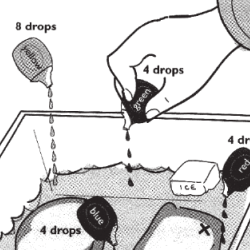Source Institutions
Source Institutions
Add to list Go to activity
Activity link broken? See if it's at the internet archive

In this simulation, learners explore how ocean currents spread all kinds of pollution—including oil spills, sewage, pesticides and factory waste—far beyond where the pollution originates. Learners create an experimental "ocean" (water in a tray) and "continents" (rocks), then add melting ice cubes to create temperature-driven currents in the water. Learners observe how "pollution," represented by food coloring, spreads through the model ocean affected by both "currents" and "continents." This activity can be used with lessons on ocean science or environmental hazards.
- Under 5 minutes
- 10 to 30 minutes
- 1 cent - $1 per group of students
- Ages 8 - 14
- Activity, Model, Simulation
- English
Quick Guide
Materials List (per group of students)
- Clear, shallow tray or salad container (1½” to 2” deep)
- Water
- 2 rocks (about ¼ size of a brick) or upside down coffee cups
- Food coloring (blue, red, yellow, green)
- One large ice cube or several small ones
- Newspaper
- Measuring cup
Subjects
-
Earth and Space Science
-
Earth Structure
- Oceans and Water
-
Earth Structure
-
Life Sciences
-
Ecology
- Human Impact
-
Ecology
-
Physical Sciences
-
Chemistry
- Solutions
-
Chemistry
-
The Nature of Science
-
The Scientific Process
- Conducting Investigations
-
The Scientific Process
Informal Categories
- Nature and Environment
Audience
To use this activity, learners need to:
- see
- see color
- touch
Learning styles supported:
- Uses STEM to solve real-world problems
- Involves hands-on or lab activities
Other
This resource is part of:
Access Rights:
- Free access
By:
- Center for Technology Innovation, Lawrence Hall of Science; Great Explorations in Math and Science, Lawrence Hall of Science
Rights:
- All rights reserved, The Regents of the University of California, 2007
